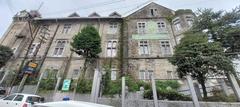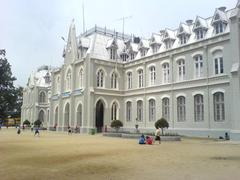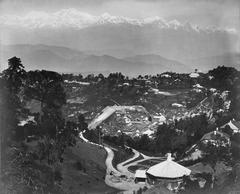
Visiting Hours, Tickets, and More: Your Guide to Lloyd Botanical Garden in Darjeeling
Date: 18/07/2024
Introduction
Nestled in the picturesque hills of Darjeeling, India, the Lloyd Botanical Garden is a sanctuary for nature enthusiasts, botanical researchers, and tourists alike. Established in 1878, this historical garden spans over 40 acres and showcases a rich tapestry of Himalayan flora, including rare and endangered species. The garden’s inception can be credited to William Lloyd, then Deputy Commissioner of Darjeeling, whose vision transformed an ordinary plot into a thriving center for botanical research and conservation (Lloyd Botanical Garden History) (Darjeeling Tourism). With its diverse plant collections, scenic walking trails, and breathtaking views of the Kanchenjunga range, Lloyd Botanical Garden stands as a testament to the enduring beauty and ecological significance of the Eastern Himalayas. Whether you are exploring the vibrant rhododendron blooms in spring or soaking in the serene landscapes during autumn, this botanical gem promises an unforgettable experience for all visitors. This comprehensive guide aims to equip you with everything you need to know for a memorable visit to Lloyd Botanical Garden.
Table of Contents
- [History of Lloyd Botanical Garden](#history-of-lloyd-botanical-gardenhistory-of-lloyd-botanical-garden)
- [Early Days: A Vision Takes Root](#early-days-a-vision-takes-rootearly-days-a-vision-takes-root)
- [A Century of Growth and Transformation](#a-century-of-growth-and-transformationa-century-of-growth-and-transformation)
- [Visiting Lloyd Botanical Garden](#visiting-lloyd-botanical-gardenvisiting-lloyd-botanical-garden)
- [Visitor Information](#visitor-informationvisitor-information)
- [Nearby Attractions and Travel Tips](#nearby-attractions-and-travel-tipsnearby-attractions-and-travel-tips)
- [FAQs](#faqsfaqs)
- [Exploring Lloyd Botanical Garden](#exploring-lloyd-botanical-gardenexploring-lloyd-botanical-garden)
- [Key Attractions and Features](#key-attractions-and-featureskey-attractions-and-features)
- [Diverse Plant Collections](#diverse-plant-collectionsdiverse-plant-collections)
- [Breathtaking Views and Scenic Trails](#breathtaking-views-and-scenic-trailsbreathtaking-views-and-scenic-trails)
- [Conservation and Research](#conservation-and-researchconservation-and-research)
- [Essential Tips for Visitors](#essential-tips-for-visitorsessential-tips-for-visitors)
- [Key Attractions and Features](#key-attractions-and-featureskey-attractions-and-features)
- [Conclusion](#conclusionconclusion)
- [Call to Action](#call-to-actioncall-to-action)
History of Lloyd Botanical Garden
Early Days: A Vision Takes Root
The garden’s genesis can be traced back to 1878 when Darjeeling was rapidly gaining popularity as a hill station. William Lloyd, then the Deputy Commissioner of Darjeeling, envisioned a dedicated space for the region’s unique flora. His vision was not merely ornamental; Lloyd aimed to create a center for botanical research and conservation.
With the help of a generous land donation from the Maharaja of Sikkim, Lloyd’s dream began to take shape. The garden’s initial area encompassed a modest 40 acres, carefully chosen for its diverse microclimates and fertile soil.
A Century of Growth and Transformation
The early 20th century saw the garden flourish under the stewardship of several dedicated curators. Notable among them was Mr. Hart Benton, who, in 1913, significantly expanded the garden’s collection and introduced numerous exotic species. His efforts cemented the garden’s reputation as a haven for botanical diversity.
The devastating earthquake of 1934 caused significant damage, decimating a large portion of its carefully curated collection. However, like the resilient Himalayan flora it housed, the garden persevered.
Post-independence, the management of the Lloyd Botanical Garden was entrusted to the Indian government. Under the Botanical Survey of India (BSI), the garden underwent extensive restoration and expansion. New greenhouses were constructed, research facilities were modernized, and conservation efforts were intensified.
Visiting Lloyd Botanical Garden
Visitor Information
- Visiting Hours: The garden is open daily from 8:00 AM to 4:00 PM.
- Entry Fees: There is a nominal entry fee for adults, while children may have discounted rates.
- Best Time to Visit: The best times to visit are during spring (March-May) when the rhododendrons are in full bloom, or during autumn (September-November) for pleasant weather and clear mountain views.
Nearby Attractions and Travel Tips
When visiting Darjeeling, be sure to explore other nearby attractions:
- Tiger Hill: Famous for its breathtaking sunrise views over the Himalayas.
- Darjeeling Himalayan Railway: A UNESCO World Heritage site offering scenic train rides.
- Padmaja Naidu Himalayan Zoological Park: Home to rare and endangered Himalayan fauna.
FAQs
Q: What are the visiting hours for Lloyd Botanical Garden?
A: The garden is open daily from 8:00 AM to 4:00 PM.
Q: How much are the tickets for Lloyd Botanical Garden?
A: There is a nominal entry fee for adults, while children may have discounted rates.
Q: What are the nearby attractions in Darjeeling?
A: Nearby attractions include Tiger Hill, Darjeeling Himalayan Railway, and Padmaja Naidu Himalayan Zoological Park.
Exploring Lloyd Botanical Garden
Key Attractions and Features
Diverse Plant Collections
The garden boasts an impressive collection of over 3,000 species of plants, many of which are rare and endangered. These are organized into various sections:
- Himalayan Temperate Collection: Showcasing rhododendrons, magnolias, primulas, and various conifer species.
- Tropical House: A greenhouse nurturing orchids, ferns, cacti, and succulents.
- Medicinal Plants Section: Featuring plants used in traditional Himalayan medicine.
- Rock Garden: Providing a protected habitat for alpine and sub-alpine plants.
- Herbarium: Housing over 20,000 specimens, aiding in research and conservation efforts.
Breathtaking Views and Scenic Trails
Beyond its botanical treasures, the Lloyd Botanical Garden offers breathtaking panoramic views of the surrounding Himalayan ranges, including:
- Kanchenjunga Viewpoint: Offering unobstructed views of the Kanchenjunga peak.
- Scenic Walking Trails: Well-maintained trails winding through diverse plant communities.
Conservation and Research
The Lloyd Botanical Garden plays a crucial role in plant conservation and research:
- Ex-situ Conservation: Providing a safe haven for endangered plant species.
- Research and Education: Serving as a center for botanical research and educational programs.
Essential Tips for Visitors
- Dress Comfortably: Wear comfortable walking shoes and layered clothing.
- Stay Hydrated: Carry a water bottle.
- Respect the Environment: Avoid littering, plucking flowers, or disturbing plants.
- Follow Garden Etiquette: Maintain silence in designated areas, avoid using flash photography inside greenhouses, and follow instructions provided by garden staff.
- Engage with Local Guides: Consider hiring a local guide for a richer experience.
- Support Local Businesses: Purchase souvenirs or refreshments from local vendors.
Conclusion
Lloyd Botanical Garden in Darjeeling is more than just a tourist attraction; it is a living repository of botanical diversity and a testament to the dedicated efforts of countless individuals over the decades. From its humble beginnings in 1878 under the visionary guidance of William Lloyd to its current status as a vital center for research and conservation, the garden has continually evolved to preserve and showcase the rich flora of the Eastern Himalayas (Botanical Survey of India). Visitors can immerse themselves in the garden’s diverse plant collections, enjoy panoramic views of the majestic Kanchenjunga, and learn about the crucial conservation efforts taking place within its boundaries. Whether you’re a botany enthusiast, a nature lover, or a traveler seeking tranquility, Lloyd Botanical Garden offers an enriching and serene escape from the hustle and bustle of everyday life. As you plan your visit, remember to respect the environment, engage with local guides, and explore the nearby attractions to fully appreciate the cultural and natural heritage of Darjeeling. For more information and updates, follow the garden’s official website and social media channels (Lloyd Botanical Garden Official).
References
- Discover the Rich History and Visiting Information of Lloyd Botanical Garden in Darjeeling, 2024, Author source url
- Exploring Lloyd Botanical Garden - Visiting Hours, Tickets, and Key Attractions in Darjeeling, 2024, Author source url
- Complete Guide to Visiting Lloyd Botanical Garden in Darjeeling - Hours, Tickets, and Tips, 2024, Author source url





